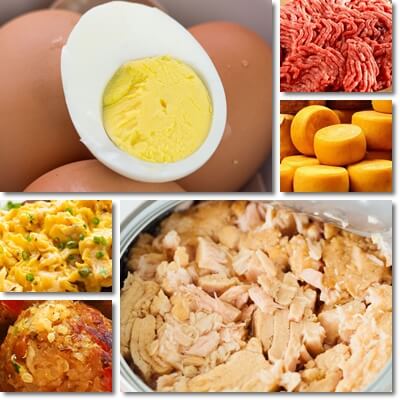Are you looking to lose some weight by lowering your carbs intake and boosting protein? Are you trying to build more muscle and need protein? Are you keto and looking for new recipes to try? Whatever your reason for needing to amp up your protein intake, these 3 healthy and high-protein recipes can help your body and brain feel not just fed, but also adequately nourished, and provide satiety, satisfaction and stress-free cooking. Try them now!
Scrambled eggs and ground (minced) meat
- Servings: 2
- Prep time: 0 minutes
- Cooking time: 20-25 minutes
- Total calories (estimated): 543 kcal (determined for ground chicken breast meat without skin), 675 kcal (determined for ground chicken breast meat with skin)
- Calories per serving: 271.5 kcal – 337.5 kcal

Ingredients:
- 220 g ground chicken breast meat (264 kcal/220 g ground chicken breast, no skin – 396 kcal/220 ground chicken breast meat with skin)
Alternatives: ground chicken leg meat, ground chicken leg and breast meat, ground turkey meat, ground beef or even pork – but expect more calories. - 2 small chicken eggs (155 kcal/100 g, 50 g/chicken egg, small)
Alternatives: 4-6 quail eggs, 1-2 duck eggs or 1 turkey egg (if you want more egg) - 1 tablespoon extravirgin olive oil (about 124 kcal/tablespoon, 14 g/tablespoon)
- Salt and pepper to taste
- Optional: 1/4 small red onion, fresh or dried thyme, oregano, sweet or spicy paprika, smoked paprika, fresh parsley, cilantro, chives.
You lightly heat up a pan and add 125 g of ground chicken breast meat and cook it on medium-low heat. Using a wooden spatula, separate the meat and spread it evenly on the pan surface. Every 2 minutes or so, turn the meat in the pan so it cooks evenly. Once the meat is cooked, add 1 tablespoon of olive oil and allow to heat, then throw in 2 small chicken eggs. Allow the eggs to cook on top of the meat for 1-2 minutes, then break apart with the spatula to mix them with the meat. Cook until the eggs are done. Season with salt and pepper according to taste.
If the recipe feels too plain and you prefer food that is more seasoned, you can add the oil at the beginning and sweat 1/4 of a small red onion, then proceed with the meat and eggs. You can also season the scrambled eggs and ground meat dish with sweet or spicy paprika, smoked paprika, thyme or oregano, or top with fresh parsley, cilantro or chives.
You can always cut down on the meat or eggs, or add to the dish. You can pair the dish with 1-2 slices of a high protein bread, flatbread or tortilla made with chickpea flour, almond flour or other nut flours. Alternatively, you can pair the dish with pickles, either pickled fruit or pickled vegetables. Or top with one tablespoon of a good mayonnaise or mustard or a drizzle of soy sauce. Your pick! But know that it will add to the energetic value of the dish.

Hard-boiled eggs with canned tuna
Hard boiled eggs with canned tuna makes for a good portable lunch, stores well and it’s hearty enough to fill you up all afternoon. Granted, it’s not anyone’s first choice, but it’s actually one of the simplest high-protein meals, with ingredients that are readily available and cost-effective, not to mention it requires minimum cooking.
- Servings: 2
- Prep time: 15-20 minutes
- Cooking time: 10 minutes
- Total calories (estimated): 525 kcal (for black olives), 535 kcal (for marinated green olives)
- Calories per serving: 262.5 kcal (for black olives), 267.5 kcal (for marinated green olives)
Ingredients:
- 1 can of tuna, preferably in brine or packed in water (165/167 grams/can, drained) (about 150 kcal/can)
- 4 hard-boiled chicken eggs (310 kcal)
Alternatives: 4 duck eggs, 2 turkey eggs, 10 quail eggs - Salt and pepper to taste
- 50 g of black olives or pickled green olives (65 kcal/50 g of black olives, 75 kcal/50 g pickled green olives)
- Optional: a sprinkle of chives, fresh parsley, a tablespoon of mayonnaise and a tablespoon of extravirgin olive oil
You hard boil the eggs. You drain the tuna and add it to a bowl. Add the eggs on top of the tuna, cut in halves, quarters or smaller pieces. Add the olives and season to taste. Top with your choice of a topping or mix in one tablespoon of mayonnaise and/or one tablespoon of extravirgin olive oil.
If it’s too much animal protein, you can always pair it with a side dish of 200 g cooked spinach or other leafy greens of your choice, 1 medium boiled potato cut in cubes, or pair with 2 red tomatoes with are somewhat more acidic or 2 yellow tomatoes which are sweeter.
Anything you add to the dish will amp up its calorie content. For example, 200 g of cooked spinach (boiled and drained) will add 46 kcal per serving. But 1 tablespoon of mayonnaise will add 95-100 kcal. Whereas 200 to 300 g of fresh tomatoes will only add 40-60 kcal to each serving.
Lentil meatballs with Gouda cheese
Lentil meatballs with Gouda cheese makes for an extremely savory, but meatless high-protein dinner that you can eat as it is, or pair with some light vegetables.
- Servings: 2
- Prep time: 10-15 minutes
- Cooking time: 1:30 hour
- Total calories (estimated): 840 kcal
- Calories per serving: 420 kcal
Ingredients:
- 200 g boiled lentils, be it brown, green lentils, red lentils, yellow lentils (228 kcal)
- 2 eggs (or 1-2 egg yolks) (150 kcal)
- 2 ounces breadcrumbs (224 kcal)
Note: exact intake of breadcrumbs will depend on egg size and how absorbent the lentils are. - 2 tablespoons of olive oil or another cooking oil (up to 248 kcal)
- Salt, pepper, herbs (fresh parsley, thyme, oregano, paprika, turmeric etc.)
- 60 g Gouda cheese (214 kcal)
Soak lentils overnight and boil until at least almost completely cooked. Crush or puree the cooked lentils. In a bowl, mix together the lentils, 1-2 whole eggs or just egg yolks, salt, pepper, herbs, oil and breadcrumbs. Form meatballs, preferably small to medium-sized and flattened to ensure even cooking and reduce cooking time without the meatballs getting too dry. Place meatballs on baking paper in the oven until cooked. Either add small cubes of Gouda cheese in the last 2-3 minutes of cooking, or top with Gouda cheese after plating.
You can also top the meatballs with fresh herbs and other toppings of your choice e.g. chives, leek, Daikon radish julienne, mustard, a mustard and honey dressing, and pair with a side of arugula salad dressed with lemon juice and extravirgin olive oil and seasoned plainly with salt. Adding a serving of 100 g of fresh arugula dressed with 1 tablespoon of extravirgin olive oil and lemon juice will only add 155-160 kcal to each serving.
If you were to eat one serving of each dish in a day, together with a vegetable side dish in the mentioned amounts, you will arrive at a total of roughly 1400-1600 kcal a day which is actually a calorie intake that actively promotes weight loss.
What are the benefits?
- You get complete protein, that is, protein with all essential amino acids from the chicken meat, eggs and tuna.
- Protein in meat, tuna, eggs and Gouda, but also lentils helps build muscle and repair damaged muscle, helps build bone matrices (inter-cellular bone tissue from which bones develop), and is essential to the immune system response.
- You get good amounts of fat from the meat, eggs, tuna and olive oil. Fats feed the brain and support cognitive functions such as learning and memory.
- Tuna contains the Omega-3 fatty acid form called Docosahexaenoic acid, or DHA. DHA Omega-3 is physically part of our brain, making up various structures like the cell membranes of neurons. DHA fatty acids actually make up half of the cell membrane of neurons, nerve cells that achieve the communication between our brain and body.
- Eggs provide vitamin A, vitamin D and zinc with benefits for skin, eyesight and immunity.
- You get cholesterol from the minced meat and egg yolks, and also mayonnaise if you do use some. The human body benefits from a limited intake of cholesterol (up to 300 mg a day) which helps produce bile acids for digestion, among other benefits.
- Eggs and tuna are low-calorie and do not cause weight gain. In fact, they are good foods to include in a weight loss diet because they provide both long-term satiety and generous nutrition.
- Lentils are high in fiber with 7.9 g of dietary fiber per 100 g. Dietary fiber helps regulate transit and relieve constipation naturally.
- Lentils are a good source of iron and vitamins B1, B5, B6 and B9 which help combat anemia and associated side effects such as pallor, tiredness and fatigue, muscle weakness, generalized weakness, malaise and more.
- Lentils are a good source of dietary magnesium which helps combat muscle cramps such as painful calf cramps and foot cramps, leg cramps at night, eye twitching and cramps under the chin.
- Lentils are low in readily digestive starch and high in slowly digestible and resistant starch which basically means they don’t raise blood sugar levels too much too much, and make a good food for diabetes.
